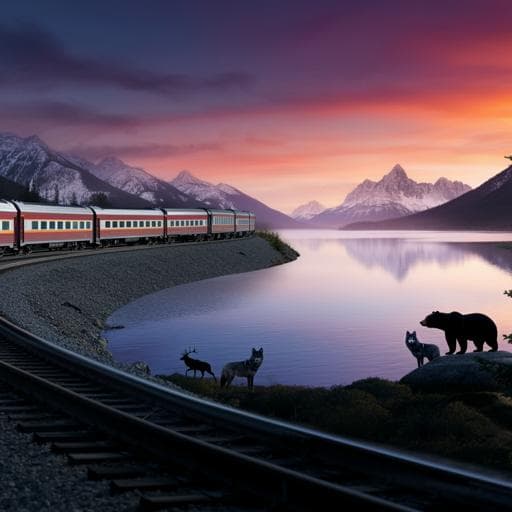
Environmental Studies and Forestry
Railway mortality for several mammal species increases with train speed, proximity to water, and track curvature
C. C. S. Clair, J. Whittington, et al.
Railway collisions pose a hidden threat to large mammals, revealing alarming mortality trends across species in Banff and Yoho National Parks. Researchers, including Colleen Cassady St. Clair and Jesse Whittington, found that increased train speeds and track curvature significantly raise the risk of fatal encounters. Discover the critical factors influencing these incidents and potential mitigation strategies that aim to protect wildlife in these beautiful yet perilous landscapes.
~3 min • Beginner • English
Introduction
The study addresses the growing problem of wildlife mortality due to vehicle collisions, with a focus on railways that have received less mitigation attention than roads. The authors examine whether mitigation should be spatially or temporally targeted versus continuous and extensive, recognizing constraints unique to railways (e.g., infeasibility of fencing and lower human injury rates reducing societal demand). They aim to identify spatial landscape factors and seasonal patterns that increase train-caused mortality for large mammals and to evaluate whether these factors are consistent across species guilds (bears, other carnivores, ungulates). The hypotheses predict higher mortality where animals have difficulty detecting trains (e.g., high speeds, high curvature, dense canopy), where movement is constrained (e.g., near water, complex topography), where forage attracts animals to the rail (e.g., spilled grain near sidings, shrub cover), and where security from humans increases rail use (e.g., farther from roads). The purpose is to inform cost-effective, targeted mitigation in mountainous protected areas and similar regions.
Literature Review
The paper reviews mitigation approaches for wildlife-vehicle collisions, noting that extensive mitigation with fencing and crossing structures is the gold standard on roads in affluent jurisdictions but may have drawbacks (e.g., fence-end effects) and high cost. Rail mitigation is comparatively underdeveloped, and extensive fencing is less viable due to operational constraints and lower human injury risk. The literature indicates hotspot-based, site- or time-specific mitigations can be effective, particularly for predictable movements (e.g., amphibian migrations, turtle nesting, ungulate corridors) and for multiple species when umbrella effects occur. Prior studies link higher vehicle/train speeds and road/track curvature with increased collision risk, and highlight the role of landscape features that channel movement (e.g., drainages, valleys). In the study area, previous work focused on grizzly bears, grain spillage as an attractant, and the potential for warning systems to improve detection and escape times.
Methodology
Study area: Banff and Yoho National Parks, Alberta/BC, Canada, along a 134 km Canadian Pacific Railway segment running through a multi-use transportation corridor with the TransCanada Highway (extensively fenced with wildlife crossings in Banff), towns, rivers, steep topography, and diverse human-use sites. Approximately 20+ trains pass daily, with increased fall traffic.
Data: Parks Canada Agency database of 646 confirmed wildlife-train mortality events (1995–2018) for 11 large mammal species. Events were reported by train crews and verified by PCA staff via site visits (species, sex/age where possible, GPS location). Events were used as units even when multiple animals died. Locations were checked for GPS errors and snapped to the rail if within 100 m. Species included grizzly bear, black bear, wolf, coyote, cougar, lynx, moose, elk, white-tailed deer, mule deer, unspecified deer, and bighorn sheep.
Spatial analysis: Two complementary designs were used for each of three guilds (bears; other carnivores; ungulates) at four spatial scales.
- Study area scale: logistic regression comparing mortality locations to 5,000 random locations distributed along the railway (~1 every 26 m).
- Local paired scales: conditional logistic regression comparing each mortality location to 100 available points along the rail constrained within radii of 2.5 km, 5 km, and 10 km (reflecting daily movement distances of species in the system).
Covariates grouped by hypothesized mechanisms (calculated at radii of 90, 210, 390 m; selected best-performing radius while controlling for multicollinearity, r>0.6, and VIF):
- Detection: maximum allowable train speed (MaxSpeed), rail curvature (tortuosity), canopy closure.
- Movement channelling: topographic complexity (terrain rugosity), distance to water, percent water cover, distance to roads.
- Forage attraction: distance to rail sidings (proxy for spilled grain), percent shrub cover.
- Security from humans: distance to roads, shrub cover, canopy closure.
Four biologically plausible two-way interactions with curvature were considered: curvature×MaxSpeed, curvature×percent water, curvature×distance to water, curvature×percent shrub.
Modeling: For each guild and scale, full models with main effects were fit, then all combinations respecting a minimum of 10 events per covariate to avoid overfitting. Models were ranked by Bayesian Information Criterion (BIC), retaining those within 2 BIC of the top model. Coefficients were presented from top-ranked models, and model fit at the study-area scale was assessed via AUC.
Temporal analysis: For each day (1995–2018), a binary variable indicated whether a mortality occurred for each guild. Logistic regression assessed effects of season using sine (spring +1 / fall −1) and cosine (winter +1 / summer −1) of day-of-year, total daily precipitation (mm), and the precipitation×winter interaction. Time-of-day was summarized by hour into day (0800–1959) vs night (2000–0759), acknowledging potential reporting-time biases. Analyses were conducted in R 3.6.1 with the survival 3.1.8 package.
Key Findings
- Dataset: 646 events across 11 species, grouped as 59 bears (black bear 47; grizzly bear 12), 27 other carnivores (wolf 15; coyote 8; cougar 3; lynx 1), and 560 ungulates (elk 328; white-tailed deer 116; mule deer 66; moose 29; deer spp. 15; bighorn sheep 6).
- Top predictors across guilds and scales: maximum train speed, proximity to water (shorter distance increased risk), percent water within 90 m, and rail curvature. These factors were consistent indicators of increased mortality risk, implicating train-detection challenges and movement constraints near water.
- Guild/scale-specific effects:
• MaxSpeed: positive association at the study-area scale for all guilds; also positive at finer scales for ungulates (e.g., 5 km: MaxSpeed estimate 0.570, SE 0.220, p=0.010; 2.5 km: 1.063, SE 0.325, p=0.001).
• Distance to water: closer proximity increased risk for all guilds (e.g., ungulates 10 km: −0.217, SE 0.052, p<0.001; 5 km: −0.232, SE 0.053, p<0.001; 2.5 km: −0.193, SE 0.060, p=0.001). Bears at 10 km showed a near-significant effect (−0.294, SE 0.156, p=0.059).
• Percent water: positive for carnivores and ungulates at finer scales (carnivores 2.5 km: 0.465, SE 0.236, p=0.049; ungulates 2.5 km: 0.212, SE 0.063, p=0.001; 5 km: 0.171, SE 0.057, p=0.003; 10 km: 0.156, SE 0.055, p=0.005). Bears showed a weak negative effect at the study-area scale (−0.278, SE 0.283, p=0.327).
• Curvature: increased risk for bears at all scales (e.g., study area: 0.408, SE 0.154, p=0.008; 5 km: 0.608, SE 0.127, p<0.001; 2.5 km: 0.561, SE 0.146, p<0.001) and for ungulates at all local scales (e.g., 2.5 km: 0.282, SE 0.070, p<0.001; 5 km: 0.191, SE 0.058, p=0.001; 10 km: 0.161, SE 0.052, p=0.002). Effects were not consistent for other carnivores.
• Distance to sidings: ungulates had higher risk near sidings (negative coefficients; 10 km: −0.359, SE 0.070, p<0.001; 5 km: −0.420, SE 0.092, p<0.001; 2.5 km: −0.457, SE 0.154, p=0.003), consistent with grain attraction. Other carnivores showed higher risk farther from sidings at some scales (e.g., 10 km: 0.554, SE 0.317, p=0.081).
• Shrub cover: positive for bears and ungulates (ungulates 2.5 km: 0.328, SE 0.057, p<0.001; 5 km: 0.266, SE 0.052, p<0.001; 10 km: 0.286, SE 0.046, p<0.001). At the study-area scale for ungulates, shrub and percent water were included with MaxSpeed and topo complexity.
• Topographic complexity: negative for bears and ungulates at broader scales (e.g., ungulates study area: −0.735, SE 0.253, p=0.004), but positive for carnivores at local scales (in top model sets).
• Distance to roads: tendency for higher mortality near roads for all guilds; consistent across scales particularly for bears (e.g., 5 km: −0.337, SE 0.160, p=0.036; 2.5 km: −0.394, SE 0.202, p=0.051).
• Interactions: evidence that higher MaxSpeed combined with proximity to water increased carnivore risk (MaxSpeed×Distance to water negative in study-area model set; estimate −0.419, SE 0.310, p=0.176 in top model).
- Model discrimination (study-area AUC): ungulates 0.735; bears 0.634; other carnivores 0.683.
- Temporal patterns:
• Ungulates: significant increases in winter (cosine 0.583, SE 0.063, z=9.3) and spring (sine 0.309, SE 0.063, z=4.9).
• Bears: top model had no seasonal covariates; second-ranked suggested increased summer mortality (cosine 0.751, SE 0.330, z=−2.3; indicating lower winter/higher summer).
• Other carnivores: no significant seasonal change; second-ranked model weakly suggested a spring increase.
• Precipitation and precipitation×winter were not important predictors.
• Diel pattern (acknowledging reporting uncertainty): night-time proportions were 43% (bears, n=54), 28% (other carnivores, n=25), and 37% (ungulates, n=537).
Discussion
The findings support the hypotheses that impaired train detection (higher speeds, greater track curvature) and movement constraints (proximity to and amount of nearby water) are primary drivers of wildlife-train collisions across multiple mammal guilds. Secondary influences from forage attraction (sidings, shrub cover) and human-related features (roads) varied among guilds, reflecting differing habitat preferences and behaviors (e.g., ungulate attraction to grain near sidings versus carnivore avoidance of human activity near sidings). Seasonal differences in vulnerability indicate that ungulates and other carnivores are most at risk in winter, likely due to snow-facilitated rail travel and limited forage, while bear mortality peaks in late spring/early summer, potentially linked to dispersal of subadults, elevated spring forage along the rail, calf-searching behavior, and high water levels that impede movement. These results provide a mechanistic basis for targeted mitigation—reducing speeds and enhancing train detectability in curved segments near water and other pinch points, and timing interventions to seasonal peaks—offering a cost-effective alternative to extensive, continuous measures that may be impractical for railways.
Conclusion
This study synthesizes 24 years of confirmed wildlife-train collisions in the Canadian Rockies to identify cross-guild spatial predictors—maximum train speed, track curvature, and proximity/amount of water—that consistently elevate mortality risk, alongside guild-specific influences such as shrub cover, topography, and sidings. It demonstrates that risk concentrates at identifiable sites and seasons, supporting spatially and temporally focused mitigation (e.g., speed reductions at curved, water-adjacent segments; site-specific warning systems; vegetation management; strategic resource placement). Future research should integrate animal movement with train operations to model exposure and hazard jointly, refine temporal “hot moments” of risk, incorporate additional geomorphic and human-use variables, and evaluate indirect effects of railways on habitat connectivity and population dynamics, particularly for less-studied species.
Limitations
- Unequal sample sizes among guilds limited covariates and statistical power for bears and other carnivores, increasing model uncertainty.
- Reliance on mortality data alone may not predict future risk if mortality induces local avoidance or depresses populations; combining collision records with animal movement is recommended.
- Important predictors were not measured, including specific barrier features (e.g., bridges, snow sheds), tributary configurations, and spatially explicit human-use intensity.
- Forest cover was excluded due to collinearity with shrub cover, though it may have independent effects in other contexts.
- Guild-based analyses may mask species interactions (e.g., interspecific avoidance among bears).
- Spatial scales for landscape covariates (90–390 m radii) may underestimate relevant scales; however, they align with escape-time distances for warning systems in the study area.
- Time-of-day of collisions was uncertain due to potential reporting-time stamps; precipitation and snow metrics were from a single station and may not reflect spatial variability across the study area.
Related Publications
Explore these studies to deepen your understanding of the subject.







